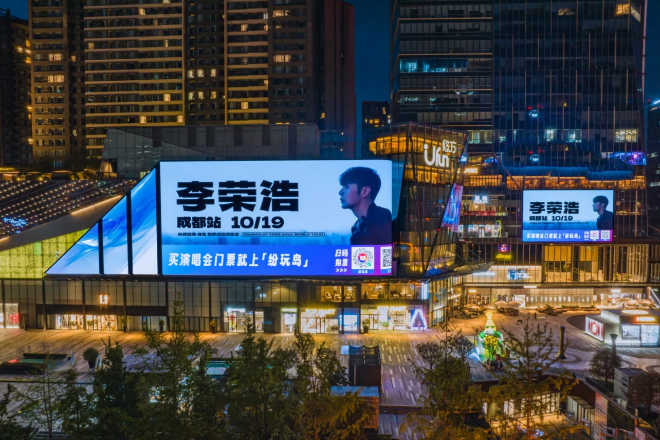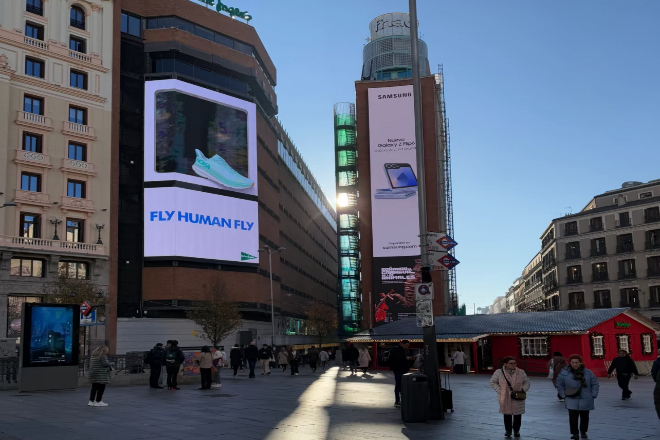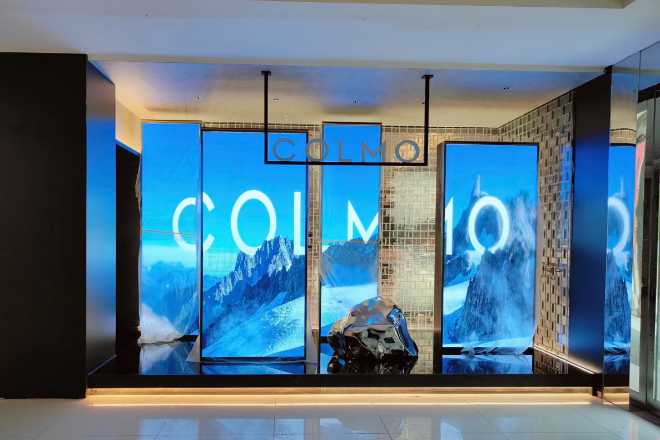مقدمة

مع التقدم المستمر للتكنولوجيا، شاشات ال اي دي يتم استخدامها بشكل متزايد في مختلف المجالات.
في بعض المناسبات، مثل توجيه حركة المرور في مترو الأنفاق، ومواقع الأحداث واسعة النطاق، والعروض التجارية، وما إلى ذلك، من الضروري تحقيق عرض الارتباط بين شاشات LED المتعددة لتوفير تأثيرات عرض معلومات أكثر ثراءً وتوحيدًا.
إذن، ما هي المتطلبات الأساسية التي يجب استيفاؤها لتحقيق ربط العديد من شاشات LED؟
الشرط 1: المتطلبات الفنية للموظفين وشاشات LED
1) نظام التحكم الموحد
يعتبر هذا المتحكم بمثابة دماغ، حيث يجب أن يكون قادرًا على إدارة جميع شاشات LED والتحكم فيها بشكل موحد.
يجب أن يكون قادرًا على استقبال المعلومات من أماكن مختلفة، مثل أجهزة الكمبيوتر ووسائط البث الشبكية وحتى المحتوى المخزن محليًا، ثم نقل هذه المعلومات بسرعة إلى كل شاشة بشكل متزامن.
يجب أن يكون لدى وحدة التحكم أيضًا قوة معالجة وذاكرة كافية لدعم عاليةدقة وتشغيل المحتوى بمعدل إطارات مرتفع حتى يتمكن الجمهور من رؤية صور سلسة وواضحة.
علاوة على ذلك، يجب أن يكون النظام قابلاً للتطوير بحيث إذا كنت تريد إضافة المزيد من الشاشات أو ترقية نظام التحكم في المستقبل، فيمكنك القيام بذلك بسهولة.
عند الحديث عن نقل المعلومات، يجب أن نذكر بروتوكول نقل الإشارة. يجب أن تدعم جميع الشاشات نفس البروتوكول، مثل TCP/IP وUDP وما إلى ذلك. وبهذه الطريقة، يمكن نقل المعلومات بسلاسة بين الشاشات المختلفة، وتحقيق التحكم عن بعد ومزامنة البيانات.
بالطبع، الأمان مهم جدًا أيضًا. يجب تشفير المحتوى المنقول، ويجب أن تكون هناك آلية مصادقة لمنع الآخرين من التجسس أو التلاعب بمعلوماتنا.
2) وحدات العرض المتوافقة
يجب أن تكون مواصفات شاشات LED المرتبطة متطابقة أو متوافقة على الأقل. ويجب أن تتطابق الدقة ودرجة البكسل لضمان تأثير عرض متناسق.
ويجب أيضًا أن يتطابق عمق اللون والسطوع حتى يتمكن الجمهور من رؤية نفس الصورة الجيدة في ظل ظروف الإضاءة المحيطة المختلفة.
يجب أن تكون الواجهات متوافقة أيضًا. يجب التأكد من أن الواجهات المادية مثل HDMI وDVI متطابقة أو يمكن توصيلها من خلال محول.
يجب أن تدعم واجهة البيانات أيضًا المعايير والبروتوكولات الموحدة حتى يمكن توصيلها وتكوينها بسرعة، مما يوفر علينا المتاعب.
3) مستقر مزود الطاقة
إذا كان مصدر الطاقة غير مستقر، فقد تصبح شاشة LED مظلمة في أي وقت، وهو أمر مروع. لذلك، يجب أن يكون هناك نظام إمداد طاقة مستقر.
من الأفضل أن يكون لديك مصدر طاقة غير قابل للانقطاع (UPS) حتى يتمكن النظام من الاستمرار في العمل حتى في حالة انقطاع التيار الكهربائي الرئيسي. يجب أن تحتوي خطوط الطاقة ومعدات إمداد الطاقة أيضًا على تصميمات احتياطية، وهو ما يكون أكثر موثوقية.
يجب أن يكون هناك أيضًا نظام إدارة طاقة ذكي. يمكن لهذا النظام مراقبة حالة الطاقة في الوقت الفعلي، مثل الجهد والتيار، ويمكنه إصدار إنذار على الفور في حالة وجود أي خلل.
علاوة على ذلك، يجب أن يدعم التحكم عن بعد حتى نتمكن من تشغيل وإيقاف مصدر الطاقة في أي وقت وفي أي مكان، مما يوفر الحاجة للذهاب إلى الموقع.
بالطبع، هذه التقنيات وحدها لا تكفي. يجب أن يقوم موظفون محترفون بتشغيل هذه الأنظمة وصيانتها. يجب أن يكونوا على دراية بتشغيل نظام التحكم ومعرفة كيفية تحرير المحتوى وجدولته ونشره.
كما يجب أن يكونوا قادرين على إجراء الصيانة اليومية، مثل تنظيف الغبار وفحص الواجهات. وفي حالة فشل النظام، يجب أن يكونوا قادرين على تحديد المشكلة بسرعة وإصلاحها.
لذلك، ليس من السهل تحقيق ربط شاشات العرض LED. يجب أن يكون هناك نظام تحكم قوي ووحدات عرض متوافقة ومصدر طاقة مستقر وموظفين محترفين للتشغيل والصيانة.
بهذه الطريقة فقط يمكننا ضمان التشغيل المستقر وتأثير العرض الأمثل لنظام ربط شاشة LED.
الشرط 2: المتطلبات الأساسية للأجهزة لشاشات العرض LED

1) وحدات شاشة العرض LED عالية الجودة
هذه هي "عين" شاشة العرض، لذا عليك اختيار شاشات عالية الجودة. يمكن لمصابيح LED الجيدة ضمان سطوع الصورة المعروضة وتشبع اللون فيها بأفضل ما يمكن، بحيث تجذب انتباه الجمهور من النظرة الأولى.
إذا لم تكن جودة حبات المصباح جيدة، فستكون الصورة باهتة، ولن تكون الألوان ساطعة، مما يقلل الجودة بشكل كبير.
دعونا نتحدث عن شريحة التشغيل. شريحة التشغيل هي بمثابة "قلب" شاشة العرض، وعليك اختيار شريحة عالية الأداء. يمكنها توفير تيار ثابت وإخراج جهد لضمان عمل شاشة العرض دائمًا بثبات.
إذا لم تكن شريحة التشغيل جيدة، فقد تومض شاشة العرض أو تشوهها أو حتى تتحول إلى اللون الأسود مباشرة، وهو أمر فظيع.
2) هيكل ميكانيكي موثوق به
بالنسبة لشاشات العرض LED الكبيرة أو المعلقة، يجب أن يكون هيكل الدعم مستقرًا. إذا كان الدعم غير مستقر، فقد تتشوه شاشة العرض أو تتلف بسبب القوة الخارجية أو وزنها، وهو أمر خطير.
لذلك، عند تصميم هيكل الدعم، يجب عليك التفكير فيه بعناية للتأكد من عدم وجود أي مخاطر.
بالإضافة إلى ذلك، بالنسبة لشاشات العرض التي تحتاج إلى الفتح أو الإغلاق أو التشويه، يجب أن تكون آلية النقل دقيقة أيضًا. يمكن تحقيق حركات سلسة ومستقرة، مما يسمح للجمهور برؤية تأثيرات الصورة السلسة والطبيعية.
إذا لم تكن آلية النقل دقيقة، فسوف تتعطل شاشة العرض وتصبح غير ناعمة عند الفتح والإغلاق أو تتشوه، مما يؤثر على تجربة المشاهدة لدى الجمهور.
3) نظام فعال لتبديد الحرارة
تنتج شاشات العرض LED حرارة أثناء العمل. إذا لم يكن تبديد الحرارة جيدًا، فسيؤثر ذلك على عمر شاشة العرض وأدائها. بالنسبة لشاشات العرض منخفضة الطاقة، يمكن استخدام هيكل تبديد الحرارة الطبيعي المصنوع بالكامل من المعدن.
وهذا لا يتطلب مراوح أو ثقوب، ويمكن أن يقلل من تراكم الغبار وتوليد الضوضاء، ويجعل شاشة العرض أنظف وأكثر هدوءا.
ومع ذلك، بالنسبة لشاشات العرض عالية الطاقة أو طويلة الأمد، يجب تجهيزها بنظام تبديد الحرارة القسري. على سبيل المثال، يمكن للمراوح أو أجهزة التبريد السائل ضمان أن تكون درجة حرارة شاشة العرض ضمن نطاق معقول.
بهذه الطريقة، يمكن لشاشة العرض أن تعمل بثبات لفترة طويلة دون حدوث أي ضرر أو تدهور في الأداء بسبب ارتفاع درجة الحرارة.
الشرط 3: المتطلبات الأساسية للبرمجيات الخاصة بشاشات العرض LED
لا ينبغي لشاشات العرض LED أن تحتوي على أجهزة قوية فحسب، بل لا يمكن تجاهل جانب البرمجيات أيضًا. يمكن لنظام البرمجيات الجيد أن يجعل التحكم في شاشات العرض LED أكثر ملاءمة، ومحتوى العرض أكثر تنوعًا، ونقل البيانات أكثر أمانًا وموثوقية.
1) برنامج التحكم المتقدم
أين يجب أن ينعكس هذا؟ أحد هذه الأمور هو الواجهة التفاعلية المرئية. يجب أن يتمكن المستخدمون من ضبط المعلمات بسهولة وتحرير المحتوى والتحكم في العروض من خلال هذه الواجهة.
تخيل مدى صعوبة العمل إذا واجهت واجهة غير واضحة! لذلك، تعد الواجهة التفاعلية المرئية ضرورية.
دعنا نتحدث عن وظيفة المعاينة في الوقت الفعلي. هذه الوظيفة عملية للغاية! فهي تتيح لك رؤية تأثيرات شاشة العرض ومصدر الإشارة والتخطيط للمشهد مسبقًا قبل العرض الرسمي.
بهذه الطريقة، يمكنك إجراء تعديلات بناءً على الوضع الفعلي لضمان أن يكون المحتوى المعروض النهائي خاليًا من العيوب.
2) نظام إدارة المحتوى الذكي
يجب أن يوفر هذا النظام أدوات تحرير محتوى سهلة الاستخدام تتيح للمستخدمين إدخال المحتوى وتحريره بسهولة بتنسيقات متعددة مثل النصوص والصور ومقاطع الفيديو.
بهذه الطريقة، يمكنك إنشاء محتوى عرض غني ومتنوع وفقًا لاحتياجاتك لجذب انتباه الجمهور.
بالإضافة إلى تحرير المحتوى، تعد وظيفة التشغيل التلقائي ضرورية أيضًا. يجب أن تكون قادرًا على تشغيل محتوى مختلف تلقائيًا وفقًا لجدول زمني محدد مسبقًا أو تشغيل حدث.
على سبيل المثال، يمكنك تشغيل ملخص الأخبار في الصباح، وتوقعات الطقس في الظهيرة، وبرنامج ترفيهي في المساء. وبهذه الطريقة، يمكن لشاشة LED تحقيق إدارة عرض ذكية وآلية، مما يوفر عليك القلق والجهد.
3) بروتوكول نقل البيانات المستقر
هذا هو حجر الأساس لنظام برامج العرض LED! يجب عليك استخدام بروتوكولات نقل البيانات الفعالة، مثل TCP/IP، لضمان دقة البيانات في الوقت الفعلي.
وبهذه الطريقة، سواء كنت ترسل نصًا أو صورًا أو مقاطع فيديو، يمكنك التأكد من وصول البيانات إلى وجهتها بسرعة ودقة.
بالإضافة إلى ذلك، يعد تشفير البيانات ضروريًا أيضًا لنقل المحتوى السري. عليك التأكد من عدم تسريب البيانات أو العبث بها أثناء عملية النقل لحماية خصوصية المستخدمين وأمانهم.
الشرط الرابع: المتطلبات الأساسية لتطبيق شاشة LED

تتألق شاشات LED الآن في جميع مناحي الحياة، ولكن لكي تلعب تأثيرها المستحق حقًا، يجب استيفاء بعض المتطلبات الأساسية للتطبيق.
1) متطلبات تطبيق واضحة
لا يعد هذا مجرد حديث عابر، بل يجب أن يكون محددًا بكل التفاصيل. على سبيل المثال، يعد مزامنة المعلومات أمرًا مهمًا للغاية. يجب التأكد من أن جميع شاشات العرض يمكنها عرض نفس المعلومات أو المعلومات ذات الصلة بدقة في الوقت الفعلي.
تخيل مدى الفوضى التي قد تحدث إذا كانت المعلومات المعروضة على كل شاشة عرض مختلفة في موقع حدث كبير! لذلك، فإن مزامنة المعلومات هي أحد المتطلبات الأساسية لتطبيق شاشات العرض LED.
دعونا نتحدث عن الاستجابة للطوارئ. في حالات الطوارئ، يمكن أن تكون شاشات العرض LED مفيدة للغاية. يجب أن تكون قادرًا على تبديل محتوى العرض بسرعة وإصدار إشعارات الطوارئ أو معلومات التوجيه لتحسين قدرات الاستجابة للطوارئ.
على سبيل المثال، في حالات الطوارئ مثل الحرائق والزلازل، يمكن لشاشات العرض LED عرض معلومات سريعة مثل طرق الإخلاء والمخارج الآمنة لتوجيه الأشخاص للإخلاء بسرعة. لذلك، تعد قدرات الاستجابة للطوارئ أيضًا شرطًا أساسيًا لتطبيق شاشات العرض LED.
2) تصميم تخطيط معقول
بالإضافة إلى متطلبات التطبيق الواضحة، فإن تصميم التخطيط المعقول يعد أيضًا شرطًا أساسيًا مهمًا لتطبيق شاشات العرض LED. وهذا يتطلب مراعاة منظور الجمهور ومسافة المشاهدة.
يجب عليك تصميم تخطيط وزاوية شاشة العرض بشكل معقول وفقًا للموقف الفعلي لضمان تحسين تأثير العرض. على سبيل المثال، في حفل موسيقي كبير، يجب التأكد من أن كل جمهور يمكنه رؤية المحتوى على شاشة العرض بوضوح، الأمر الذي يتطلب تصميمًا دقيقًا لتخطيط وزاوية شاشة العرض.
بالإضافة إلى ذلك، يعد التكيف البيئي أيضًا أحد الاعتبارات المهمة في تصميم التخطيط. يجب مراعاة العوامل البيئية لشاشة العرض، مثل الضوء ودرجة الحرارة والرطوبة وما إلى ذلك. تختلف متطلبات شاشات العرض في البيئات المختلفة.
على سبيل المثال، يجب أن تتمتع شاشات العرض المستخدمة في الهواء الطلق بخصائص مقاومة للماء والشمس، بينما قد تولي شاشات العرض المستخدمة في الأماكن المغلقة اهتمامًا أكبر لإعادة إنتاج الألوان والوضوح. لذلك، عند اختيار نوع ومواصفات شاشة العرض، يجب مراعاة العوامل البيئية بشكل كامل.
خاتمة
لتحقيق عرض الربط بين شاشات LED المتعددة، من الضروري تلبية المتطلبات الأساسية للتكنولوجيا والأجهزة والبرامج والتطبيق. فقط عندما يتم استيفاء هذه الشروط بالكامل يمكن ضمان استقرار وموثوقية وفعالية ربط العرض.
مع التطور المستمر للعلوم والتكنولوجيا، فإن آفاق تطبيق ربط شاشات LED ستكون أوسع، مما يوفر حلولاً أكثر كفاءة وملاءمة وذكاءً لعرض المعلومات ونشرها في مختلف المجالات.
وأخيرا، إذا كنت تريد معرفة المزيد عن شاشات LED، يرجى الحصول على اتصال معنا.
